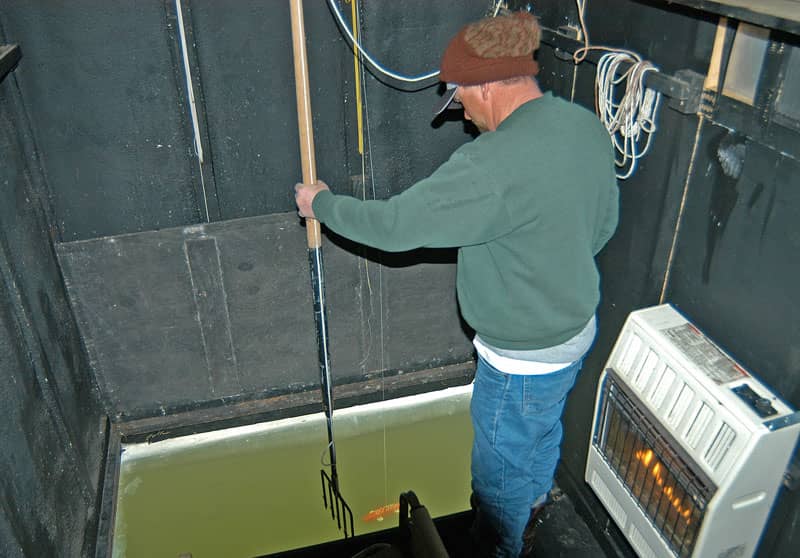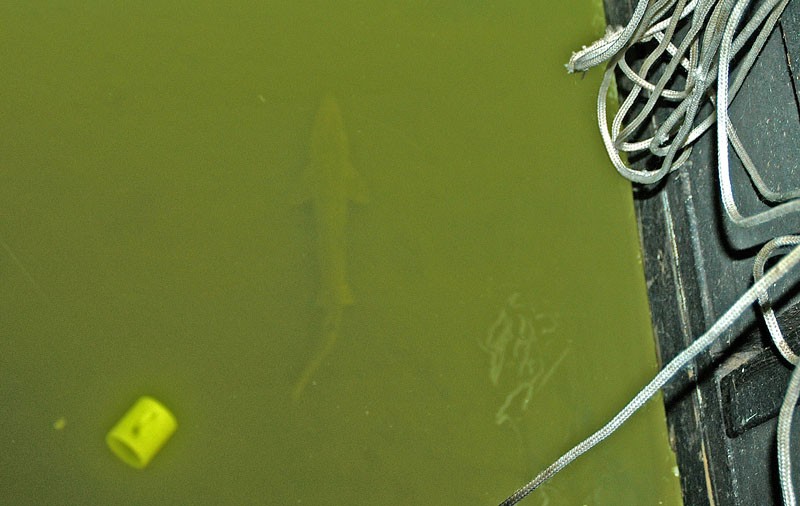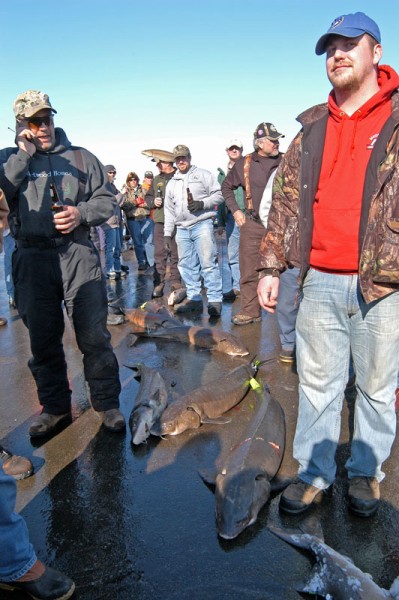Want to Find Success During Sturgeon Season? Check Your Water Clarity
Patrick Durkin 03.30.16

Sturgeon spearers on Lake Winnebago and its upriver lakes in east-central Wisconsin have little choice but to lower their expectations when Mother Nature clouds the water beneath their refrigerator-size holes in the ice each winter.
Even so, stalwart spearers stay optimistic while on watch during February’s spearing season, just hoping a passing sturgeon stays high in the water column. Back ashore, pessimists and less-committed spearers find other things to do in murky-water years. If they can’t see a lake’s mud-lined floor, they think it’s futile to wait for feeding sturgeon to forsake their bottom-vacuuming habits.
After all, even when lake bottoms are visible, success rates aren’t great. Maybe that’s because each spearing hole covers about four-hundred-thousandths of Lake Winnebago’s 215.2 square miles of surface ice. What are the odds of even one sturgeon passing through such tiny windows?
But whether you’re an optimist or pessimist, water clarity is sturgeon spearing’s No. 1 factor. And visibility this winter was below average, as was spearing success.
“You can’t spear what you can’t see,” said Ryan Koenigs, the Department of Natural Resources’ senior fisheries biologist in Oshkosh and the Winnebago System’s sturgeon expert. “Spearers understand the sturgeon haven’t gone anywhere. They’re always out there. This was just one of those years when the sturgeon won.”

When the 16-day season ended Feb. 28, spearers had taken 396 sturgeon on Lake Winnebago. Spearing on the upriver lakes – Poygan, Winneconne and Butte des Morts – closed Feb. 19 when spearers got within one fish of the 95-fish quota for adult females, capping the total upriver-lakes’ harvest at 307. Water clarity is usually less of an issue on the upriver lakes because they’re shallower than Winnebago.
This winter’s season on Winnebago differed starkly from the past two years, which closed early with kills of 1,858 in 2015 and 1,513 in 2014. Those totals rank in the top 11 seasons in Winnebago’s 75-year history of regulated sturgeon spearing, with water clarity averaging 15 feet in 2014 and 12 feet in 2015.
In contrast, when DNR crews checked Winnebago’s water clarity the week of Feb. 8, it ranged from 7 to 10 feet, and averaged 9 feet. The DNR expects below-average sturgeon spearing when visibility is 11 feet or less.
Koenigs said water clarity slowly improved after opening weekend, and varied from 9 to 12 feet by location as the season’s final week began Feb. 21. To gauge visibility, DNR staff lie on the ice with a dark blanket covering their head, and lower a white disk into the water until they can’t see it. The rope holding the disk is marked in feet, and the measurement is taken from the ice’s bottom edge.
The cause of this winter’s poor water clarity included several factors, which began with December’s warm weather. The region experienced heavy rains instead of snow, and little to no ice cover on these big lakes.
“People started calling with their concerns around Christmas,” Koenigs said. “All that rain flushed a lot of dirty water into the system, and then the lack of ice kept the sediments stirred up by wind and waves. Nothing settled out. Typically, we get the best clarity when the lakes freeze early and a decent snow covers the surface to reduce light. The more light that reaches the water, the more algae blooms cloud the water.”
Yes, algae can bloom in winter. Koenigs said these aren’t the blue-green algae that cause “pea soup” in summer. Rather, it’s brown algae, which can bloom in cold water from direct sunlight.
Winnebago’s top five spearing seasons were 1995 with 3,173 sturgeon; 1990, 2,908; 1982, 2,238; 1998, 2,051; and 1953, 2,044. All those years featured good water clarity. It’s not surprising that three of those top five seasons occurred since 1990. In fact, in sturgeon spearing’s history, 18 of the best 30 seasons (60 percent) and only four of the worst 20 seasons (20 percent) occurred since 1990.

Koenigs said it’s also no coincidence that water clarity has been consistently better since 1990. That’s when citizens began working with the DNR to craft and implement the Winnebago Comprehensive Management Plan, which improved wetland and shoreline habitats throughout the system. Those efforts reduced the amount of nitrogen, phosphates and agricultural run-off reaching the region’s waterways.
Koenigs and other biologists doubt the zebra mussel invasion of recent years is having much impact on water clarity. Even though zebra mussels filter algae from water, they probably don’t remove enough to make a big difference.
“Zebra-mussel colonies aren’t as substantial as they are in other systems because Winnebago and the upriver lakes have mucky bottoms,” Koenigs said. “Zebra mussels need rock and gravel to cling to, but at least 85 percent of Lake Winnebago’s bottom is mud.”
The three decades preceding the 1990s’ environmental turnaround produced some of the Winnebago System’s worst spearing. Koenigs refers to the 1960s, ’70s and ’80s as the system’s “Dark Ages” because water clarity was consistently poor. In fact, in sturgeon spearing’s history, 12 of the worst 20 seasons (60 percent) occurred during that period.
Even so, the sturgeon population grew those years, which helps explain why spearers killed record numbers during the 1990s’ best years for visibility. All that success helped drive new spearing regulations, including harvest quotas and caps starting in 1999, and the six-hour spearing day (7 a.m. to 1 p.m.) in 2002.
What lies ahead for sturgeon spearing? It’s tough to predict. After all, sub-400 harvests in 2000 and 2006 were followed by 1,000-plus kills in 2001 and 2007, while 2012’s 324-fish kill was followed by a 306-fish kill in 2013.
With the right conditions, however, don’t be surprised if Winnebago’s harvest in 2017 again exceeds 1,000. After all, that’s happened nine times already in this new century.

